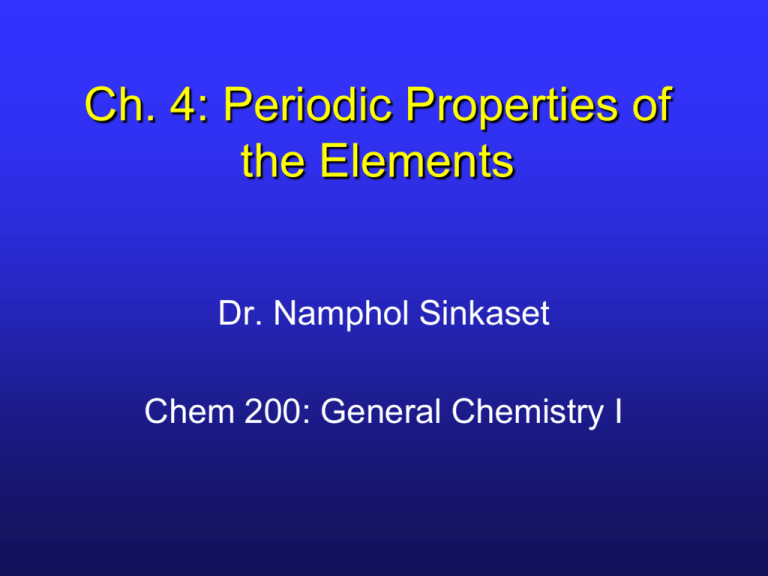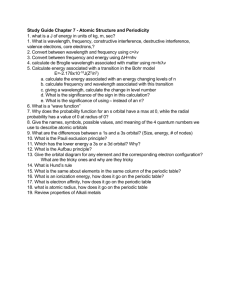Ch. 8: Electron Configuration and Chemical Periodicity
advertisement

Ch. 4: Periodic Properties of
the Elements
Dr. Namphol Sinkaset
Chem 200: General Chemistry I
I. Chapter Outline
I.
II.
III.
IV.
V.
VI.
VII.
Introduction
The Periodic Table
Electrons in the Atom
Electron Spin
Sublevel Energy Splitting
Using the Periodic Table
Periodic Properties and Trends
I. Organizing Chemical Info
• When information of the elements was
organized, chemistry began to advance
quickly.
• Element “triads” and “octaves”
• Mendeleev’s periodic table in 1869
• Quantum mechanics explains why the
periodic table appears as it does.
II. Periodic Law
• Initially, Mendeleev ordered elements
by increasing atomic mass.
• Later work by Moseley showed that they
should be ordered by atomic number.
II. The Modern Periodic Table
II. Major Divisions of the Table
• Main-group elements have properties
that are largely predictable based on
their location.
• Transition and inner-transition elements
have properties that are less predictable
based on their location.
• Each column within the main group
region is known as a family or group.
III. Electrons Occupying Orbitals
• From Chapter 3, we know how orbitals
are ordered for the hydrogen atom
• Since hydrogen has only one e-, the
ground state can be written as an
electron configuration:
III. Many e- Atoms
• The Schrödinger equation can’t solve
multi-e- atoms; we only get approximate
solutions.
• We use quantum #’s from H atom
solution to describe orbitals of other
atoms.
III. New Considerations
•
•
An atom with more than 1 e- is more
complicated.
Two more concepts are needed to
understand these larger atoms:
1) Electron spin
2) Sublevel energy splitting
IV. H Atoms in a Magnetic Field
IV. e- Spin
• e- generate a small magnetic field as if
they were spinning.
• There are two possible directions e- can
spin, so there are two possible states.
• spin quantum number (ms) can be either
+1/2 or –1/2.
IV. Representing e- Spin
• Orbital diagrams are used to show
electron occupation and spin.
IV. Pauli Exclusion Principle
• No two e- in the same atom can have
the same 4 quantum #’s!!
• H: n=1, l=0, ml=0, ms=1/2
• He has two p+, so it needs two e-:
1st e-: n=1, l=0, ml=0, ms=1/2
2nd e-: n=1, l=0, ml=0, ms=-1/2
• The orbital is filled and the e- have
paired spins.
IV. Electrons in Helium
V. H vs. He Energy Levels
• One additional e- complicates the He
spectrum greater than expected. Why?
V. Removal of Degeneracy
• In H atom, energy of an orbital depends
only on n.
e.g. Energies of 3s, 3p, 3d are degenerate.
• In every other atom, this is not true.
E (s orbital) < E (p orbital) < E (d orbital) <
E (f orbital), etc.
• What removes the degeneracy?
V. Sublevel Energy Splitting
•
Three factors contribute to differing
sublevel energies:
1) Coulomb’s Law (Z)
2) shielding
3) penetration
V. Coulomb’s Law
1
q1q2
E
40 r
• The PE of like charges is positive (unstable),
but decreases as they move apart.
• The PE of unlike charges is negative (stable)
and increases as they get closer.
• The magnitude of the interaction increases as
charges on particles increases.
V. Nuclear Charge
• p+ in nucleus
constantly pull all e-.
• Higher charges
attract more strongly.
• More p+ lowers
orbital E by
increasing e-/nucleus
attraction.
V. Shielding
• Electrons shield each
other from the full
charge of the nucleus.
• The effective nuclear
charge, Zeff, is the
actual positive charge
an e- feels.
V. Penetration
• The movement of an
outer e- into the
region occupied by
inner e- is called
penetration.
• Penetrating eexperience higher
nuclear charge,
lowering its PE.
V. 2s and 2p Radial Distribution
V. 3s, 3p, 3d Penetration
• This is the reason why energetically, s < p < d.
V. Order of Sublevels
V. The Aufbau Principle
• Since e- are “lazy,” they want to
“occupy” the lowest energy level
possible.
• Thus, if we know the energy order of
sublevels, then we can “build up” the econfigurations of each atom.
V. Writing e- “in” Orbitals
•
Two ways to represent how e- are
situated in atoms:
1) e- configuration, nl#
2) orbital diagram, which uses arrows
indicating e-’s and their spin
V. Hund’s Rule
• In the orbital diagram of C, there was a
choice as to where to place the 2nd p
orbital.
• We follow Hund’s rule.
When filling degenerate orbitals, electrons
fill singly first with parallel spins.
• Hund’s rule leads to lower energy.
V. Examples
VI. The Periodic Table
• As you go left to right on the periodic table,
you are using the Aufbau principle.
VI. The Periodic Table
• Each region of the periodic table indicates
what orbitals are being “filled.”
VI. Using the Periodic Table
• You can use an element’s location to
write its full or condensed electron
configuration/orbital diagram.
VI. Using the Periodic Table
• Therefore, Cl is: [Ne] 3s2 3p5.
• From the orbital diagram, we can write
specific quantum numbers for each e-.
• Which e-’s are identified with the
following quantum #’s {n, l, ml, ms}?
{3, 0, 0, -1/2}
{3, 1, 1, 1/2}
VI. Some Caveats
• Because energy differences between s
and d are small, some exceptions to
how e-’s fill exist.
Same for d and f.
• Remember that d principal quantum #
lags by one.
• Remember that f principal quantum #
lags by two.
VI. Sample Problem
• Write condensed electron configurations
and orbital diagrams for the following
elements.
Mn
Sb
Nd
VI. The Periodic Table
VI. Important Parts of the Periodic Table
1) Each element placed in box w/ atomic #,
atomic mass, and atomic symbol.
2) Atomic # increases as go L to R.
3) Each horizontal row is period.
4) Each vertical column is a group or family.
5) Main group elements are in groups 1,2
and 13-18 (s and p blocks).
VI. Important Parts of the Periodic Table
6) Transition elements are in groups 3-12 (d
block).
7) Inner-transition elements at the bottom
(lanthanides and actinides, f block).
8) Staircase line separates metals on L
from nonmetals on R. Metalloids or
semimetals lie adjacent to the line.
9) Some groups have special names: alkali
metals, alkali earth metals, halogens,
noble gases.
VI. Types of Elements
VI. Core vs. Valence e-’s
VI. Valence Electrons
• valence electrons: the outermost e- in
an atom
• Valence e- determine an atom’s
chemistry; thus, atoms in the same
vertical column have similar chemical
properties.
• Valence e- can be determined from the
Group number.
VI. Formation of Ions
• Metals tend to lose e-’s and nonmetals
tend to gain e-’s.
• Main-group ions can be predicted.
VI. Transition Metal Cations
• When forming transition metal cations,
remove e-’s from highest n-value orbital
first!
V: [Ar] 4s2 3d3
V2+: [Ar] 4s0 3d3
VI. Magnetic Properties
• Some metals exhibit magnetism
paramagnetic: atom or ion that has
unpaired e-’s
diamagnetic: atom or ion in which all e-’s
are paired
VI. Sample Problem
• Draw condensed orbital diagrams for
the following and determine whether
they are diamagnetic or paramagnetic.
Sc3+
Ir2+
Mn4+
VII. Atomic Radii
VII. Trend in Atomic Radii
Trend in Atomic Radii
VII. Trend in Ion Size
• Why?
VII. Trend in Ionization Energy
• ionization energy:
energy in kJ needed to
remove an e- from
gaseous atoms/ions
• Why?
• What about 1st, 2nd, 3rd,
ionization energies?
VII. Successive IE’s
VII. Electron Affinity
• electron affinity:
energy change in kJ
when e- added to a
gaseous atom/ion
(generally negative)
• Why?
VII. Trend in Metallic Character







